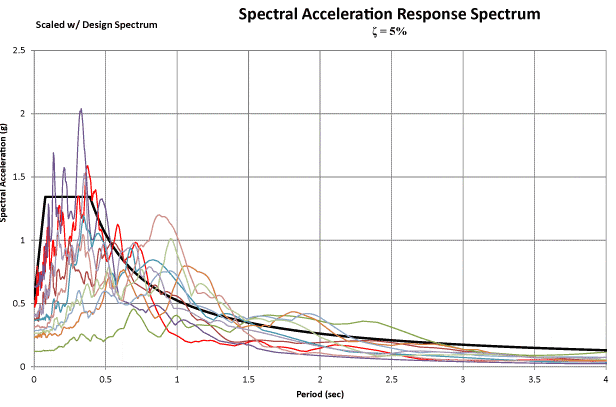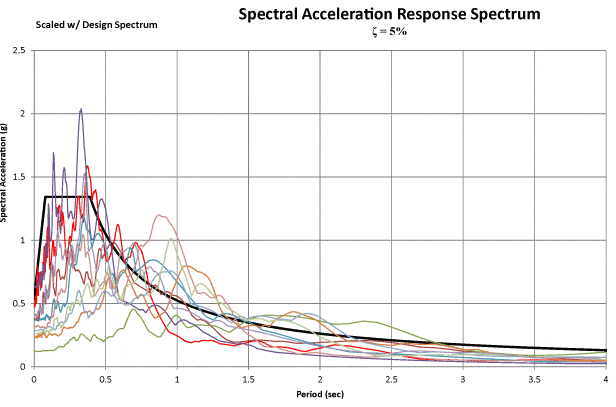Seismic safety is tested for structures in areas at risk of earthquakes. Additionally, important structures like dams, tall buildings, etc. are tested and designed for earthquake resistance regardless of whether they are located near a plate boundary or not.
What is an earthquake?
Ground movement in vertical and horizontal directions due to interplate movement, volcanic events, etc.
This movement in the ground is transferred directly to the support structure. Structural design is the crucial factor that determines whether this structure can withstand the loads that occur during this type of event.
In general, it depends on the relationship between capacity and applied load.


What happens during an earthquake?
As mentioned previously, ground movements cause structures to move in the direction that earthquake waves move.
Most of the time the waves are horizontal.
Due to the lateral movement of the ground, the building shakes. This movement produces two deformations in the structure, namely flexural deformation and shear deformation.


Furthermore, shaking subjects the structure to different stages of movement. These are called eigenshapes. These basic modal forms are taken into consideration during design.


What is the difference between wind loads and earthquake loads?
Both types of load cause the structure to vibrate. Furthermore, both types of loads can be applied statically or dynamically and proceed with construction.
The main difference between these types of loads is the magnitude and time interval in which they act on the structure. Furthermore, the variation in applied loads is not of a similar nature.


How does an earthquake happen?
An earthquake is a sudden displacement along a fault.
Tectonic plates are in constant movement. Its edges are formed by friction between the two planes. The relief of overcoming friction is like an earthquake for us.
Seismic events are observed at plate boundaries. The following plate boundaries were found. Essentially, there are seven tectonic plates.
- African dish
- Antarctic plate
- Eurasian Plate
- Indian-Australian Plate – (Australian Plate and Indian Plate)
- North American plate
- Pacific Plate
- South American dish


The movement of the Tiptronic board can be illustrated in the following figure.
It causes ground movement. Sometimes permanent deformations occur in the ground after an earthquake.


What is seismic design?
Design a structure that can withstand the stresses of an earthquake. Loading is dynamic in nature and both diorama analysis and static analysis can be used for analysis and design.
Earthquake resistant design codes provide structural engineers with comprehensive guidance on the parameters to consider depending on the magnitude of the earthquake, type of structure, soil conditions, etc.
There are three main methods for designing a structure.
- Static analysis
- Response Spectrum Analysis – Dynamic Analysis
- Time History Analysis – Dynamic Analysis
Static Analysis in Earthquake Design
Static analysis is the simplest method for calculating and analyzing loads. It is a comparatively simple and uncomplicated method.
The following steps are performed in static analysis:
- Select the maximum ground acceleration (PGA) of the structure to be designed. This value can be found in local or international standards based on the seismic zone in which the structure is located.
- If the site is far from a plate boundary, the minimum PGA value or the value specified in the design intent may be used.
- Calculate base shear based on PGA and other parameters.
- With this method we take into account that the mass of the structure is concentrated on each floor. The base is based on the mass of each floor and the height of each floor from the ground, the thrust of the base is distributed across each floor.
- We can then continue with the analysis normally.
- However, we must define material properties taking into account their nonlinear effects, as we expect structures to behave outside the linear range during an earthquake.
- Depending on the result of the analysis, a draft may be created.
The worked example UBC Earthquake Resistant Design Example 1997 For more information on the base shear calculation method, see.
Further clarification could come from the article Principles of Earthquake Resistant Construction on the background.
Additionally, the article performance-oriented design For more information on nonlinear analysis of structures of this type, see the following.
Response spectrum analysis
This is one of the dynamic analysis methods in earthquake design. First, we need to find the appropriate response spectrum for our project.
Furthermore, it is mainly used in the analysis of buildings in earthquake-resistant designs.


With regard to the response spectrum method, the following can be highlighted. – Source: Internet
- Response spectrum analysis allows the peak response of a structure to be estimated in the form of displacement, velocity, or acceleration.
- This method is often used to determine structure response in earthquake design.
- Furthermore, it is a method that measures the contribution of each natural period of vibration to indicate the likely maximum seismic response of a substantially elastic structure.
Time course analysis
Time history analysis is also one of the dynamic analysis methods used in earthquake resistant design.
Time history analysis is a linear or nonlinear assessment of the dynamic response of a structure subjected to a load that varies as a function of time.
This feature may be related to a previous seismic event.
Important Factors to Consider in Earthquake Safety Planning
Several factors must be taken into consideration when designing earthquake resistance.
Subsequent deflections or displacements, damping, ductility details, structural configurations, etc. are some important factors to consider when designing structures for seismic loads.
Lateral deformations
The most preferred type of deformation is translational movement. If no torsion modes form in the first two modes, we are satisfied.
If the torsional modes do not reach their initial modes, the torsional deformation of the structure is minimal.
However, this is not always possible for us because our structures are not always symmetrical. There may be deviations in the center of gravity and center of rigidity.


In cases where we cannot avoid torsional modes, we must design the structure for torsion. Attention must be paid to the fluctuations of weak elements and shear forces in the structure.
One should always try to avoid torsional modes within the initial modes by changing the structural stiffness. Adjustments to shear wall stiffness, change of location, etc. could be done to solve this problem.
History Deviation/Deviation Index
This is a requirement for the operability of the building and also represents a kind of limitation to the lateral deformation of the structure.
Constraints should be made based on the relevant standard used for the seismic design.
Otherwise, non-structural components such as cladding, ceilings, mechanical equipment, etc. may be damaged by excessive lateral deformation.
The limit is provided in UBC 1997. For more information on this topic, see the article UBC 1997 Earthquake Resistant Design Could Be Forwarded.
damping
Damping is a phenomenon in which the energy of a vibrating object decreases over time. This reduces the oscillation amplitude over time.
The following figure shows the input dissipation due to attenuation.


The structure itself has a damping property. The vibration caused by an earthquake is dissipated by the structure itself without the need for external energy absorption devices.
However, as the vibration amplitude increases, cracks form in the structure and the damping properties are lost.
In modern construction, many methods are used to improve the comfort of buildings by attaching shock absorbers.
To reduce vibration in the building with earthquake resistant construction, the following methods are used.
- Viscose shock absorber
- Viscoelastic shock absorbers
- Friction damper
- Vibration damper (vibration damper)
- Compatible shock absorbers
- Magnetic dampers
This type of damping method is used in tall buildings. Smaller buildings are generally not equipped with such systems.
Naturally, the damping properties of small buildings are inferior and they cannot dissipate their energy through lateral deformations, as there are buildings that are more rigid to lateral deformations.
Furthermore, this is avoided by the infill walls in these types of structures.
Therefore, small buildings are exposed to major damage in an earthquake.
Ductility detail
It is one of the most used methods in construction, regardless of whether the building is in a seismic zone or not.
Even if the structure is not designed to withstand seismic loads, the reinforcement detailing of these structures is carried out in accordance with the ductility detailing requirements.
More information about reinforcement in detail in the article Seismic detailing of beams and columns could be forwarded.
Additionally, the article Principles of Earthquake Resistant Construction You can find more information about the ductility of a structure here.
Building configuration
Building configuration is very important in earthquake resistant construction.
Irregular buildings are subject to torsions due to the deviation of the center of gravity and rigidity. To avoid torsional movements, expansion joints must be provided, lateral stiffness changed, shear walls inserted, etc.
Side load transport system
The Transverse Load Resisting System carries the horizontal load acting on the building during an earthquake.
The stiffness of the elements that support lateral loads determines the extent of damage to the structure.
Other different structural shapes could be used against lateral loads for better performance.
Basic insulation
One of the most famous methods in modern construction for protecting buildings against earthquakes.
As we know, tall buildings are subject to very high seismic loads, which entails significant additional costs for the lateral load absorption system. Therefore, it was very difficult to build tall buildings in an area where earthquakes are common.
Using basic isolation methods made this possible. Base insulation limits, but does not prevent, lateral movement of the building. There will be a certain force for which the structure must be designed.

 The basic insulation method required further study to develop suitable materials and the cost of such a project could be high.
The basic insulation method required further study to develop suitable materials and the cost of such a project could be high.
The condition of the material in the system must be monitored as it may deteriorate over time. If necessary, it must be replaced.
Additionally, base insulator materials may be replaced after an earthquake depending on assessment of material condition.



